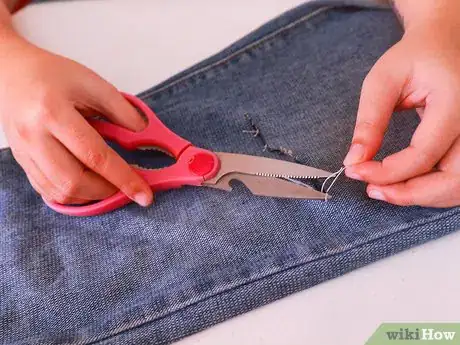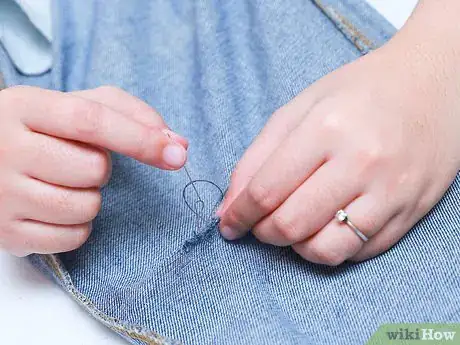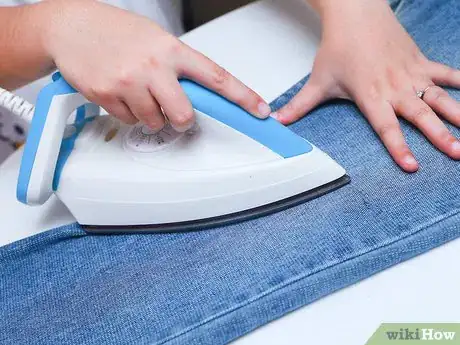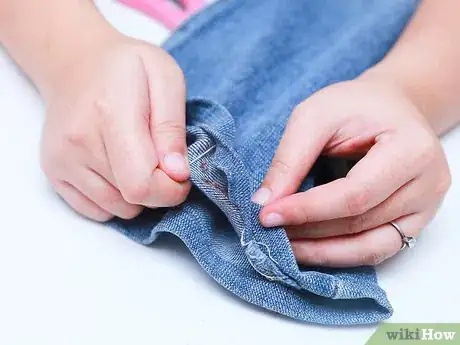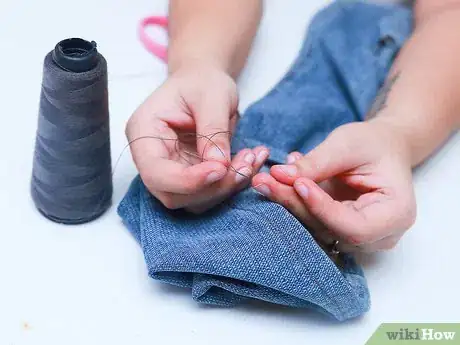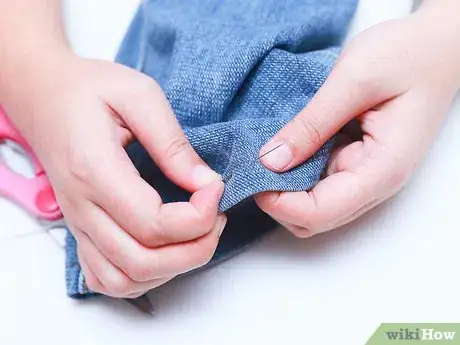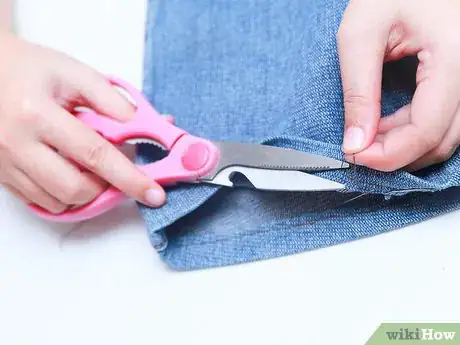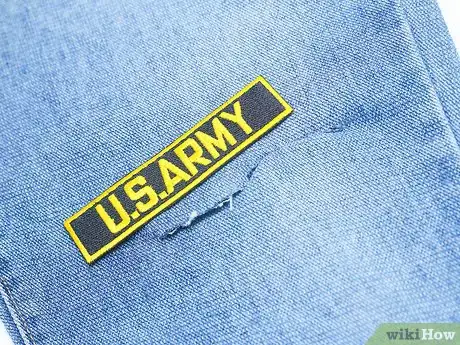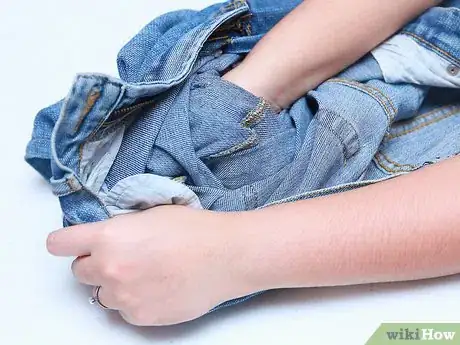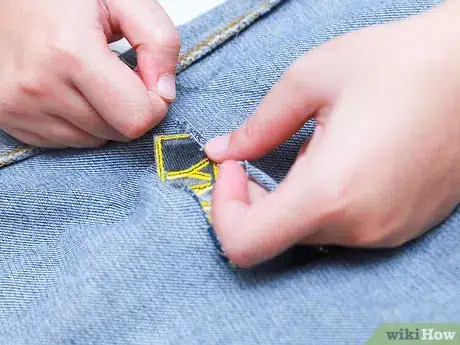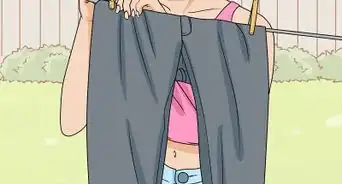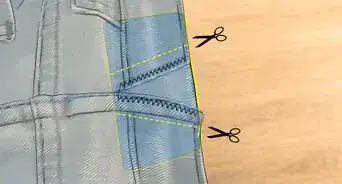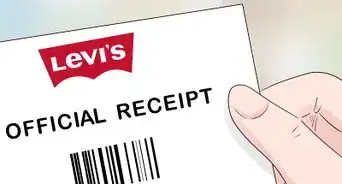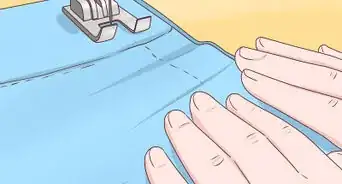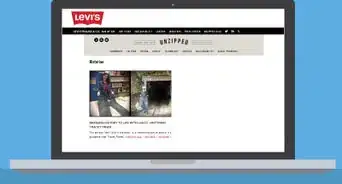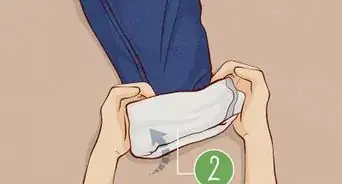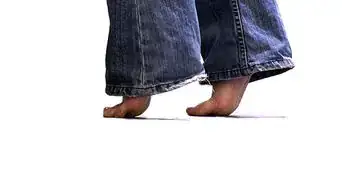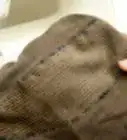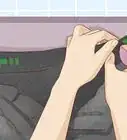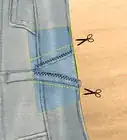This article was co-authored by Mia Danilowicz. Mia Danilowicz is a Master Tailor who works onset and on the red carpet in Los Angeles, California. With over a decade of experience, Mia specializes in bridal and gown couturier fittings, garment reconstruction, and custom design. Mia has worked at the Oscars, Grammys, SAG Awards, and Golden Globes. Her clients include a long list of entertainment and fashion industry headliners, major fashion magazines, luxury consumer brands, and popular media. Mia was trained at the Fashion Institute of Design and Merchandising and received her AA in Fashion Design and BS in Business Management.
This article has been viewed 341,005 times.
Jeans are generally more rugged than most other types of clothing. That doesn't mean, however, that they're not going to suffer some wear and tear as time goes by! It can be very discouraging when a well-loved pair of jeans gets damaged. Fortunately, it's pretty straightforward to save your jeans from the dumps. Whether it's a burst seam or a gaping hole, solutions are available!
Steps
Fixing a Tear
-
1Cut off the frayed edges. Before you get to properly repairing your jeans, you'll first need to cut the excess threads, or frayed edges caused by the tear. Take some scissors and try to cut reasonably close; you want to get rid of any protrusions, but you also don't want to lose any material you can otherwise save. [1]
-
2Sew up the tear. Provided you haven't lost much material, you can usually mend smaller rips without using any patches. First, turn your jeans inside out; that way, when you sew, the new seams won't be as visible. Take a sewing needle and thread, and stitch back and forth until the rip is mended. Try to make the stitches as close as possible.
- If it's available, try to use thread that's the same as the seam as the rest of the jeans. In many cases, this will be a white or black thread. If the rip is in a conspicuous place far away from natural seams, it's recommended you choose a colour that best fits your jeans' regular colour (usually blue or black).
Advertisement -
3Cut all excess thread and remaining protruding material. Once you get the rip sewn up, you can proceed to cut the extra bits off. Be sure to cut the sewing thread as close to the jean material as you can. If there are any frayed edges you didn't catch the first time around, give them a cut now. [2]
-
4Give your jeans a once-over with a clothes iron. Now that you've made the repair, you'll want to seal the jeans with an iron press. This will smooth out any creases and give your pants a fresh feeling of newness.
Mending a Torn Seam
-
1Recognize the distinction between tear types. Mending a torn seam should be approached differently than a regular tear; the fabric in seams is usually much more reinforced than the rest of the pant legs. While this can make it more challenging than stitching regular fabric together, mending a seam rip will look much better in the end; if done correctly, it'll be near-impossible to tell there was a problem to begin with!
-
2Assess the damage and prepare thread. In the vast majority of cases, you'll find a torn seam is a few centimetres at most. Unless the tear is minuscule or much more significant, it is generally good form to cut a length of thread that's around the length of your arm. Seam stitches tend to be very tightly woven, and the thread will disappear faster than you might think. If you even up with excess at the end of mending, you ca always cut the extra thread off at the end.
- Make sure to choose a thread that resembles the existing stitching as closely as possible. This doesn't always match up with the colour of the jeans themselves-- some denim brands tend to prefer golden thread. Choosing a close colour will make the repairs look harder to recognize.
-
3Closely sew the thread across the torn seam. [3] Hold the fabric and the broken seam together and slowly stitch them back together. It is highly recommended that you try to follow the pre-existing stitch pattern. The closer you're able to get to replicating that pattern, the harder it will be for anyone to detect there was a repair in the first place.
- You'll need a stronger needle to penetrate the thicker seam fabric.
-
4Cut off any excess thread at the end. Once you've sewn shut the extent of the tear, you should take some scissors and cut off any excess thread as close as you can.
-
5Iron the seam. It's always good measure to iron out the seam once you're done with the sewing. This will smooth out any creases in the thread and help seal in your repairs.
Patching a Hole
-
1Get a patch that suits the style of your jeans and size of the hole. When it comes to bigger holes that cannot be mended with a single seam, your best bet is to look into getting a patch-- an extra piece of fabric you can integrate into your jeans to cover the hole. You can find patches at a local arts and crafts or clothing specialty outlet. Buy a patch that matches the colour of your jeans as closely as possible. You'll want to get a patch that's slightly bigger than the hole you're covering; that way, you'll have some extra room to make errors.
- While denim patches are the safest bet if you're looking to really repair your jeans, you can take the damage as an opportunity to stylize your jeans with brightly coloured or flannel patches. Adding a patch that will clearly stand out from the rest of the clothing will give it a down-to-earth flair. While denim (or 'masked' alterations) are best sewn in on the inside of the jeans, patching different fabrics to the outside of your jeans will make them more prominent and eye-catching. [4]
- If you're feeling thrifty, you can harvest your own patches from jeans you don't use anymore.
-
2Cut frayed edges. If you have a bigger hole that will require a patch, you should still cut off the frayed edges. Even if it sounds like you are consciously losing material, the frayed edges won't be any help in mending it, so it's best to get rid of them, leaving a clean hole. Take some scissors and cut excess threads around the hole. By the end, there shouldn't be any threads significantly sticking out. [5]
-
3Turn your pants inside out. With patches in particular, it's recommended you turn your jeans inside out while you're patching them. That way, the most visible seams won't be externally visible. It'll also give you a bit of extra room to make sewing mistakes.
- It's typically better to sew a denim patch in from the inside. This will make the patch look less evident, as well as cover up the most visible stitch lines.
-
4Sew the patch with close-knit seams. Once you've got your jeans turned inside out, take a sewing needle and thread and sew the patch. Try to keep your sewing as close as possible; you want to integrate the fabric into your jeans as closely as closely as possible.
- Use thread that matches the color of the denim as closely as possible.
- If you're using a sewing machine, opt for a zig-zag stitch.
-
5Iron your patch out. Ironing your jeans following a patch is significantly more important than ironing a small tear. This will help even out and seal the patch.
Community Q&A
-
QuestionI have a hole in my jeans, but it is in the crotch area, so I can't put a patch on it. How do I fix it?You can apply a patch of matching denim to the inside of your jeans to cover the hole if you really can't part with them.
-
QuestionIf I rip my jeans by the back pocket, can I sew them?
 Community AnswerYes, remove the stitching where the pocket is sewn to the jeans. If the rip isn't too big, you can zigzag stitch the rip shut on a sewing machine, then stitch the pocket back on. If the rip is large, use a patch on the inside of the jeans, then follow the same process as before.
Community AnswerYes, remove the stitching where the pocket is sewn to the jeans. If the rip isn't too big, you can zigzag stitch the rip shut on a sewing machine, then stitch the pocket back on. If the rip is large, use a patch on the inside of the jeans, then follow the same process as before. -
QuestionI ripped my jeans completely. What can I do?
 Community AnswerFollow the steps here to fix them.
Community AnswerFollow the steps here to fix them.
Warnings
- Don't hold off on repairing for too long. It can take as little as four weeks for a small rip to evolve into a full-blown hole, and the damage gets progressively worse (and harder to repair) with time. Catch the problems early on and you'll save yourself hassle in the long run.⧼thumbs_response⧽
- Make sure not to hurt yourself with the sewing needle!⧼thumbs_response⧽
References
- ↑ http://www.theguardian.com/lifeandstyle/2014/aug/11/how-to-mend-your-jeans
- ↑ http://www.manmadediy.com/users/dan_e_t/posts/2651-the-diy-tailor-an-easy-way-to-fix-holes-in-your-jeans-and-other-garments
- ↑ http://www.marthastewart.com/274965/how-to-patch-a-hole-mend-a-seam-and-fix/@center/277000/homekeeping-solutions
- ↑ https://www.youtube.com/watch?v=vKwOKHT_AxI
- ↑ http://www.manmadediy.com/users/dan_e_t/posts/2651-the-diy-tailor-an-easy-way-to-fix-holes-in-your-jeans-and-other-garments
- ↑ http://www.manmadediy.com/users/dan_e_t/posts/2651-the-diy-tailor-an-easy-way-to-fix-holes-in-your-jeans-and-other-garments
- ↑ http://www.theguardian.com/lifeandstyle/2014/aug/11/how-to-mend-your-jeans
About This Article
To repair a tear in your jeans, start by cutting the frayed edges around the tear with scissors. Next, turn your jeans outside in so your repair will be less visible and then sew the tear shut by hand. Try to use a thread that's the same color as the seams of your jeans so your repair looks less obvious. To finish, remove any extra material or excess thread and give your jeans a once over with an iron to smooth out any creases. For tips on how to mend a torn seam in your jeans, keep reading!
